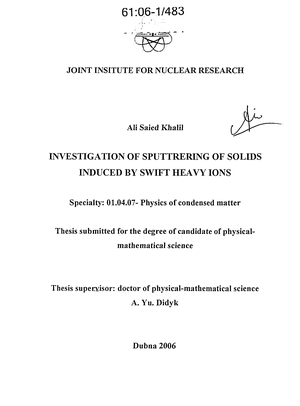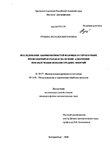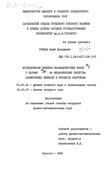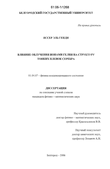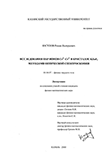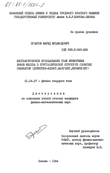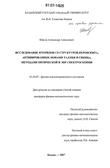Содержание к диссертации
Введение
CHAPTER 1. The phenomenon of inelastic sputtering by swift heavy ion irradiation
1.1. Phenomenon of inelastic sputtering by swift heavy ion irradiation 18
1.2. Dependence of inelastic sputtering on the structure of targets 26
1.3. Theoretical models of inelastic sputtering 29
1.4. Relaxation of electronic excitations and models of inelastic sputtering of metals 36
1.5. Conclusion 41
CHAPTER 2. The temperature in tracks of heavy ions with highly specific ionization energy loss in model of thermal peak 42
2.1. Introduction 43
2.2. Temperature effects in model of thermal peak 44
2.3. Pressure dependence of model parameters 54
2.4. Numerical scheme of calculation and algorithms 56
2.5. Approximate evaluation of temperature in ion track 61
2.6. Conclusion 65
CHAPTER 3. Influence of defect structure on the surface sputtering of metals and stainless steel under swift heavy ion irradiation in inelastic energy loss regime
3.1. Introduction 67
3.2. Ion facility for irradiation of samples by swift heavy ions 70
3.3. Experimental methods and results of sputtering of metals and steel under irradiation with swift heavy ions at high fluences 75
3.4. Experimental results and models of gold sputtering irradiated by 86Kr ions 89
3.5. Conclusion 102
CHAPTER 4. The changes of surface structure of highly oriented pyrolitic graphite (hopg) under irradiation with swift heavy ions
4.1. Introduction 105
4.2. Observation of inelastic induced surface effects in HOPG 109
4.3. Conclusion 124
CHAPTER 5. The surface changes of silicon single crystal under irradiation by swift krypton ions
5.1. Introduction 127
5.2. Surface changes of crystalline silicon irradiated by swift krypton
5.3. Temperature estimations based on thermal spike model
5.4. Conclusion
Conclusion
References
Acknowledgments
- Relaxation of electronic excitations and models of inelastic sputtering of metals
- Numerical scheme of calculation and algorithms
- Experimental methods and results of sputtering of metals and steel under irradiation with swift heavy ions at high fluences
- Observation of inelastic induced surface effects in HOPG
Введение к работе
The study of materials in radiation environments gained particular significance after the creation of nuclear power reactors. Radiation has joined other hostile and severe environmental conditions facing modern engineering materials in many important technological applications.
Such applications that involve significant levels of radiation include: power and research nuclear fission reactors, proposed fusion reactors, nuclear waste management, ion accelerators, ion accumulating rings and spacecraft, with types of radiation encompassing wide energy ranges and species such as; thermal and fast neutrons, light and heavy ions and energetic gamma quanta (photons).
Most of the change experienced by materials is unfavorable for the performance of materials, justifying the influence of radiation being referred to as Radiation Damage. Extensive ongoing research are carried out to broaden the accumulated database of the behavior of materials in radiation environment, beside the applied work, extensive fundamental research on radiation effects has been pursued, because the bombardment of materials with energetic particles especially with high energy heavy ions, offer a unique method to produced athermally, controlled and large concentration of atomic order disturbance, both on the surface and of the bulk, the extent of the disturbance can be measured by some change in an important physical properties, especially surface structure, so called surface sputtering and bulk properties which despite the wealth of accumulated information and proposed models are not so well understood.
The properties of the irradiated metals have received the most attention, where it had been identified as one of the most important design problem for the implementation of commercial fusion reactors.
In addition the primary recoiled spectra of ion irradiation can be systematically varied when by the appropriate selection of ion masses and energies, the predominant cascade energies of an irradiation can be varied from tens of eV s to hundred of keV s per amu. The current ability of accelerators to deliver up to several tens of MeV/amu, means that it is now possible to use well-defined parallel beams of ions which deposit huge energy densities into materials where linear electronic stopping powers can be up to 80 keV/nm, which far exceeds the nuclear stopping power, the exploration of the ions energy loss in this region, gives rise to several unexpected new and exciting phenomena as the production of latent tracks in dielectric and semiconductor materials and the inelastic sputtering with very high sputtering coefficients.
In most cases, however, the microstrucrure and property evolution in these materials are determined by the outcome of a competition between a large number of microstructural and microchemical mechanisms, subsets of which often work in opposite to each other. The outcome can change in favor of one mechanism or subset of mechanisms over others in response to variation in environmental or material variables. In some cases, the dominant variable may be masked, or uncontrolled by other competing variables, exerting an influence on the investigation.
If one desire to isolate and study the action of one particular mechanism, it is best to use pure metals or model alloys, thereby reducing the number of competing mechanisms. In the current study several pure metals in addition to alloys were chosen not only because of their technological relevance in fusion technology but also as represented models, to avoid the complex analysis problems which may arise from the composition and to simplify any theoretical applications of the results which can be extrapolated to the exploration of radiation-induced microstructural and mechanical change that have been observed in more simple metals or alloys of engineering importance. As far as the author s knowledge, this was the first time the investigated materials were subjected to the irradiation conditions and combination of ion species, fluences, and energies.
During the last decades, extensive body of literature has accumulated, reporting different aspects of elastic sputtering phenomenon. Sputtering by ions is the erosion of solid surfaces during ion bombardment [1]. Most studies were directed on the description of elastic (nuclear) sputtering under irradiation by low energy heavy ions [1-12]. The theoretical aspects and cascade model of elastic sputtering are presented in refs. [1, 2 ,4].
But during the last three decades, continuous scientific efforts were directed to investigate the phenomenon of inelastic sputtering (see ref. [13, 14] and references there in). This field has begun by using the fission fragments to study the sputtering of various materials. During these studies several peculiarities of surface phenomena in metals, alloys, dielectrics, semiconductors and amorphous materials have been observed. Such as the high values of sputtering coefficients in dielectrics and small dispersed targets with the grain sizes less then 10 nm were sputtering coefficients were of two or three orders of magnitude higher then of coarse-grained targets [13, 16].
However, the investigations of the above peculiar phenomena used experimental methods developed to study the elastic sputtering phenomena by low energy ions (energy is up to a few MeV) [1, 10-12].
The creation of high-energy heavy ion accelerators with the large intensities (more then 1012 ion/c) of ion beams stimulated an expanding and active area of research of the influence of swift heavy ion irradiation on the properties of solids [14, 15, 17-28, 31-43]. Most of such investigations developed the main principles of interactions and observations of the impact of single heavy and/or highly charged particles (ions, clusters of ions as Aun, Arn+, (N2)n+ and others [31, 32, 34 36] and more recently compound projectile species such as fullerens (C60) [37-43]) on solids. The high intensity of electronic energy deposition and subsequent registration of the so-called latent heavy ion tracks in solids [14, 15, 21-24, 26-28, 37, 40, 42, 43] and the estimation of parameters like: the threshold energy for track creation, diameter, density of defects inside the latent tracks and so on.
In general there exist few theoretical descriptions of the observed phenomena: the thermal spike model (in other words "hot track") and Coulomb explosion [13, 14, 27 and 28], twice charged surface layer [13], the model of isolated grain [13, 16], the "hot spot" model [13] and some other combinations of these approaches. Unfortunately, the behavior of different materials with various properties under the irradiation by swift heavy ions is not yet clear.
Indeed, in this field of studies, there are plethora of effects to consider. First there is a concern of the influence of the ion irradiation conditions such as; temperature of irradiation, ion fluence, ion flux, the influence of ion velocity, the level of elastic and inelastic energy loss. Second there are concerns of the influence of target parameters such as; the bond energy of the surface atoms, the threshold energy of atom displacement, the concentration of impurities, defect concentrations (point defects, clusters of defects, extended defects: dislocations, interstitial and vacancies loops), the concentration of a free electrons (in conductors, semiconductors and dielectrics), single crystalline, polycrystalline or amorphous solids, the size and shape of grains and it s bond energy with the substrate; bulk, surface and phase structures.
The application of swift heavy with the high level of inelastic energy loss and light ions for the study of radiation phenomena in condensed matter gave unique insights to observe number of peculiarities in the damage creation processes which can not be explained from the point of view of traditional approach using the mechanism of elastic collisions.
The study of sputtering of solids under fission fragments initially and subsequently by using modern techniques of accelerated heavy ions showed that the sputtering processes don t agree with the elastic sputtering theory developed in [2, 44, 45] whereby experimental observations are quite different than observations of solid sputtering observed by low energy ion irradiation [1, 3, 6-12].
The study of the effects of highly ionized charged ions in solids has the great importance because of the installation and commissioning in exploitation the accelerators and ion accumulating rings of heavy ions with high energy, as well as, the study of determining the radiation resistance of construction materials, which are potential materials to be used in thermo-nuclear reactors. The development of accelerator techniques, the creation of powerful collective heavy high energy rings, the evolution of the thermonuclear reactors have formulated specific requirements for the properties of structural material used in these technologies.
As an example, in a study [25] made on the accumulation of heavy ions in accumulator rings based on LINAC3 accelerator of heavy ions in CERN, sputtering and erosion of surface wall material were found to play a significant role in the accumulation process. In particular, The surface of the structural steel was first cleaned/flushed by bombardment of Ar (90%) - 02 (10%), followed by annealing at 350° С for long time (up to 24 h) at high vacuum, the structural stainless steel was then irradiated by 207Pb+27 and 207Pb+33 with energy 4,2 MeV/a.m.u. The desorption of gaseous spices of H2, CH4, CO, C02 had the value approximately 2-Ю4 mol/ion. This value is considered a very high and leads to the rapid deterioration of vacuum near the position of impact of lead ions on the surface of the ring. The scattering of accumulated ions by the evolved gaseous molecules and atoms causes noticeable decrease in the current of ion beam or its complete extinction. Therefore sputtering has very adverse and crucial effect, which must be taken into consideration for future designs.
Such technological problems require an intensive fundamental investigations as the results presented in this thesis. The obtained results are very useful from both the fundamental physics of irradiation damage and the applied applications point of views.
The purpose of the work undertaken in this thesis is to gain new insights and experimental results in the field of interaction of swift heavy ions with condensed matter, the study of the processes of radiation damage and of the influence of cumulative high damage levels on subsequent processes of sputtering. The investigations of the surface features and changes of the surface of metals, alloys, Highly Oriented Pyrolytic Graphite (HOPG) and silicon after swift heavy ion irradiation.
For the observation of the post-irradiation surface features, the main techniques used in this thesis are Scanning Electron Microscopy (SEM) and Scanning Probe Microscopy such as Scanning Tunneling Microscopy (STM) and Atomic Force Microscopy (AFM).
The dissertation work consists of introduction, five chapters and a conclusion. The formulation of the problem and brief description of results is presented at the beginning of each chapter.
Chapter 1 is devoted to the description of the inelastic sputtering of materials. An attempt has been made to present a survey of experimental works of the sputtering processes by fission fragments and heavy ions, and some theoretical models for inelastic sputtering of materials is discussed.
Chapter 2 is dedicated to the consideration of the thermal spike model developed firstly for the two-dimensional case in a few original fundamental articles [46-49] and then used for the temperature calculation in the experimental studies [37-43, 50-54]. The main advantage of the presented system of equations is the description of the three-dimensional case for the calculations of lattice and electron temperatures (as [56-58]). The influence of pressure, induced by high temperature in the volume around swift heavy ion trajectory was taken into account. The estimations of temperature in the area surrounding an ion track are presented. The numerical calculations and description of the temperatures of lattice and electrons are carried out for the case of nickel irradiated with the uranium atoms for the comparison of numerical results obtained in two and three-dimensional cases.
Chapter 3 is devoted to the presentation of experimental results in the field of sputtering of metals and alloys under swift heavy ion irradiation. First of all the sputtering of polycrystalline nickel was studied. It was observed that the sputtering at the periphery of the grains i.e. grain boundaries (intergranular) is much stronger then the sputtering inside the grain surface (intragranular). The sputtering process also led to smoothing of the surface features present before irradiation. The method of "mask/step" was used for the determination of surface sputtering coefficients. The estimations of temperature in area around the swift heavy ion track are carried out. The study of surface features on the chromium-nickel samples irradiated with the krypton ions at room temperature allowed one to observe the hillock (semispherical) structures, which cover the surface completely. The study of cold deformed gold samples irradiated by swift krypton ions allowed one to estimate the sputtering coefficient comparing it with the sputtering coefficients of various types of surface structures of gold samples such as small-grained structure, single crystals and polycrystals and others.
Chapter 4 is devoted to the discussions of surface sputtering phenomenon of the Highly Oriented Pyrolitic Graphite (HOPG) under irradiation by various swift heavy ions. HOPG is a very interesting crystal with a very good surface quality. The HOPG crystal is a unique case, because it has very unusual properties as all quasiwo-dimensional single crystals. In this crystal the distances between carbon atoms in the direction parallel to the surface is less then in perpendicular direction, therefore thermal and electronic conductivities in parallel and perpendicular directions differ very strongly (anisotropic crystal). Usually the quality of such crystals is well enough, i.e. the defect concentration is very low. The procedure for the preparation of samples of such crystals for the irradiation and the subsequent studies using the scanning tunneling or atomic probe microscopy is strightforward. During the investigations of good quality HOPG, it has been established that the sputtering from within the grain surface is practically absent, but the sputtering at the grain boundaries (intergranular) is very high under the irradiation by swift krypton ions. Nevertheless, it was observed that craters were created by swift bismuth ions impact and that the concentration of such craters was only about 1% of the bismuth ion fluence. It means that the creation of craters and sputtering of good quality HOPG has a stochastic/probablistic nature.
Chapter 5 presents the results of the changes of surface structure of single crystalline silicon at relatively high ion fluence of irradiation. Atomic Force Microscopy (AFM) was used to observe the resultant surface features, whereby hillock-like features (hemispherical) were observed on the irradiated surface. The shape of these features is similar to the features observed for single crystalline silicon sputtered under low energy argon ions. The sputtering coefficient of silicon under irradiation by krypton ions (the fluence was 1014 ion/cm2) was estimated using the comparison of surface images under irradiation by swift krypton ions and bombardment by low energy (100 and 300 eV) argon ions up to the high fluence (more then 1017 ArVcm2). The sputtering of silicon under irradiation by high inelastic energy loss is presented.
The more important results and basic propositions for defense of the thesis are presented in last conclusion chapter.
The combined results, presented in this work, solve a number of basic problems of the physics of sputtering of various materials under irradiation by high energy ionizing charged particles. The investigated effects have very important significance not only for fundamental science, but also for applications in relevant technologies. The basic results were reported and discussed on the following scientific International Conferences: VI(1996), Щ1999), X(2000), ХЦ2001), ХЩ2002), XIV(2004) and XV(2005) International Conferences "Radiation Physics of Solids" (Sevastopol, Ukraine); Third (1999), Fourth (2001) and Fifth (2003) Schools and Workshops on Cyclotrons and Applications (Cairo, Egypt), 15th International Conference: "Ion-Surface Interaction ISI-2001" (Zvenigorod, Russia, 2001); XIV International Conference on Physics of Radiation Phenomena and Radiation Material Studies (Alushta, Ukraine, 2004); V International Conference "Interaction of Irradiation with Solids" (Minsk, Belarus, 2003); "Structural basis of material modification by means of methods of non traditional technologies." (Obninsk, MNT-VII, Russia, 2003); Conference: "Influence of External Factors on Elemental Base of Apparatus for Aviation and Cosmic Techniques" (Korolev, Russia, 2003); Xth Jubilee Scientificechnical Conference with the Participation of Foreign Specialists: "Vacuum Science and Techniques" (Crimea, Sudak, 2003); 35 International Conference on Physics of Charge Particle Interaction with Crystals (Moscow State University, 2005).
The results were discussed on the scientific seminars of Flerov Laboratory of Nuclear Reactions (JINR, Dubna, Moscow Region, Russia), Tabbin Institute for Metallurgical Studies (Cairo, Egypt), Institute of Experimental and Theoretical Physics (Moscow, Russia), Nuclear Research Center (Cairo, Egypt) and some others relevant institutions.
The materials presented in the current thesis have resulted in 23 publications; consisting of 5 journal papers (both in Russian and International journals), 10 reports and 7 abstracts on Conferences, 1 JINR Communication.
The published results were referedo in the body of the thesis (see [57-79]).
Relaxation of electronic excitations and models of inelastic sputtering of metals
Sputtering of solids take place whenever the constituent atoms get energy higher then the surface bond energy in that solid allowing them to leave the surface. In the case of elastic sputtering, if the energy transferred from an impinging ion to a target atom is more then the displacement energy this may result in a sequence of elastic collisions with the surrounding atoms ensuing a cascade of displaced atoms; with energy higher then the bond energy [10-12]. In the case of swift heavy ions the transfer of energy is mostly to the electronic subsystem (inelastic) of the solid.
Inelastic sputtering is a complex phenomenon, since it involves the conversion of the energy from the electronic (potential) energy into atomic motion (kinetic energy). In the case of inelastic transfer of energy it was thought that target atoms don t get significant energy if electron subsystem is excited as this follows from the fact that electronic relaxation time is very short while the energy transfer from electrons to target atoms is much longer. This is the reason behind the difficulties of the inelastic processes to fully describe the observed sputtering of materials.
The experiments discussed in [13] give the first direct evidence of inelastic sputtering existence. It was shown that the coefficients of sputtering of solids such as АтОг and PuH2 increases with the increase of the energy of fission fragments. This observation was in conflict with the developed theory of cascade sputtering and previous data about the well characterized phenomenon of elastic sputtering and proved that sputtering can be caused by inelastic energy loss. Subsequent investigations of ion and fission fragment bombardment of metals, oxides, fluorides, solid gases and organic materials have shown that inelastic sputtering by fission fragments and ions can take place and is governed by entirely different mechanism [13]. The sputtering coefficients due to inelastic spattering have much higher values then yield for elastic sputtering (described by simple cascade model). Thus it imperative to know how is the energy is transferred from the electronic subsystem into the atoms imparting kinetic energy to them and leading to the observed high sputtering coefficient.
When the ion enter into a solid, it leaves behind a small but highly ionized cylindrical zone along its path, with a strong electron deficiency in its center. Part of this electronic excitation energy may now be transferred into kinetic energy of the target atoms by essentially two different mechanisms; Thermal Spike or Coulomb explosion as depicted in Fig. 1.1.
In the "thermal spike" model, the assumption is the thermalization of the electronic system to occur within approximately 10 s. In the following picoseconds electron-phonon coupling results in dramatic heating of the lattice and the generation of a Gaussian-like temperature profile around the ions path. Two coupled equations describe the energy diffusion from the electron subsystem to the lattice subsystem. The only free parameter is the electron-lattice interaction mean free path X while macroscopic thermodynamic parameters are invoked to calculate the heat. If the electronically deposited energy density is sufficiently high, the temperature may rise above the melting point and a molten cylinder of around several nanometers in diameter forms. After several tens of picoseconds rapid quenching of the melt to the ambient temperature take place.
The Coulomb explosion model is based upon the assumption that the electrostatic repulsion between the positively charged atoms in the centre results in an explosion-like atomic motion which overcomes the local bonding and propagates radially from the ion path, imparting kinetic energy to the surrounding lattice atoms.
Numerical scheme of calculation and algorithms
The study of the influence of irradiation by swift heavy ions at high inelastic energy loss interval in solids was developed in the last 15-20 years particularly at research centers with heavy ion accelerators facilities. The problems of ion track creation were connected with two models: coulomb explosion model and thermal spike one. With the development of some modern techniques for the study of irradiated surfaces (such as Scanning Tunneling Microscopy (STM) and Atomic Force Microscopy (AFM)) the possibilities of irradiated surface investigations obtained new aspects.
The investigation of the interaction of swift heavy ions with metals and alloys posed an interesting problem both from fundamental and application point of views. The current view that in metals it is impossible to observe "ion tracks" under irradiation by swift heavy ions and that the inelastic energy loss influence of heavy ions is not registered as observable defects. As it is impossible for the temperature around the ion trajectory to be comparable with the melting or evaporation temperature of the metal because the hot electrons have enough time (about 10 s) for energy dissipation. The characteristic time for electron-phonon interaction is about 10-12 s, this is much higher then the electron-electron interaction time. As a result the thermal spike model cannot work in this case and the damage can be produced by elastic energy loss only. Now new experimental results showed that the picture of swift heavy ion interaction with matter is much more complex. From previous works on the phenomena of tracks, the structure of the volume around the heavy ion trajectory has the following characteristics; a core with high concentration of damage with radius of about i?i 50 A, surrounded by an area with radius (R2 100 A) where the concentration of damage is less than in the core [28]. Research on the sputtering of coarse-grained metals by heavy ions in the inelastic energy loss range was started only about ten years ago in connection with acceleration and storage requirements for high-intensity heavy ion drivers [25]. The sputtering yields of coarse-grained gold irradiated by high-energy J U and Kr ions have been measured experimentally [107], and experimental data on the sputtering of Au, Zr and Ті by Au swift ions were obtained recently [107]. As shown from the analysis of these experimental results, the difference between the experimental sputtering yield and the yield calculated according to cascade theory ф is generally insignificant. In heavy ion driver systems the ions will irradiate the structural metal components, where they create defects in the initial poiycrystalHne structure as a result of elastic collisions. These defects persist and accumulate during irradiation. In this case subsequent sputtering mechanism can be changed [52, 108, 109]. The purpose of the following investigation is to verify an applicability of the thermal spike model for the description of sputtering processes and track creation in metals and alloys at high ion fluences. We will study the changes in the surface structure during ion irradiation of some important metals and alloys. 3.2. ION FACILITY FOR IRRADIATION OF SAMPLES BY SWIFT HEAVY IONS The general scheme of ion beam line for fundamental and applied research at U-400 cyclotron is shown in Fig.3.1 [110, 111]. The first experimental setup presented in this figure (following the beam direction) was designed to investigate the Single Event Effect in semiconductor devices. This part includes a movable ion scattering foil holder (1), a surface-barrier semiconductor detector (2) and a facility for irradiating integral circuits in vacuum or in air (3). In the last case ions extracted from vacuum through a stainless steel foil of 13.8 um thickness. Ion flux on the tested targets can be up to 5 103 ions/cm2/s. After the quadruple magnetic lens (4) and the deflection magnets (5) the ion beam intensity and spatial beam distribution are measured in the diagnostic section with movable Faraday cup (6) and a rotating wire detector (7). The conditions for continuous control of intensity and ion beam distribution on the transport line used for applied research demand special beam detectors, which essentially must not distort the spatial distribution of the ion beam on the target. In the experimental practice usually wire detectors are used. These detectors are inconvenient for ions with energy ranging from 1 to 10 MeV/amu, because such detectors distort the beam, which leads to shading effects on the target. In addition, in the case of high intensity ion beams these monitors are unreliable because of the overheating and consequently the destruction of the wires. One more disadvantage is that the wire detectors require several preamplifiers (one for each wire) or multiplexed switching which present several difficulties when measuring small currents of order of nA.
A rotating wire detector (7) certainly in most cases meets the requirements of the continuous monitoring of the beam shape and intensity. Such detectors are widely used at the U-400 cyclotrons in the Joint Institute for Nuclear Research (JINR) Dubna. A single wire moves in the beam in two X and Y direction in a perpendicular direction to the beam plane, so that it has the least disturbance on the beam and information might be obtained about both X and Y spatial distribution.
In the case of irradiations up to high ion fluences (of order of 10 ions/cm ) with focussed ion beam, water or liquid nitrogen cooled sample holder (8) is used, placed in the diagnostic section. This sample holder is a small stainless steel cryostat. The temperature can be changed from 80 К to about 450 К this is controlled by a thermo-resistance and a copper-constantan thermocouple. The sample is fixed on the copper block of the sample holder with conductive silver glue. The thermocouple is fixed to a control sample, located beyond the zone exposed to the beam.
Experimental methods and results of sputtering of metals and steel under irradiation with swift heavy ions at high fluences
The presence of radiation defects in metals essentially amplifies the influence of inelastic energy loss of fast heavy ions as shown that in this case the sputtering yields increase significantly. The sputtering yield for metals having only small concentration of defects in its crystalline structure is about 1-10 atom/ion [52, 107 109]. Experiments shows that the sputtering yield for coarse-grained metals under swift heavy ion irradiation is increased by factor 3 times of order at high irradiation fluences ( 2xl0 ion/cm ) this is because the effect of radiation-induced defects accumulation in the crystal during irradiation of the target. The experimentally observed high sputtering yield for nickel is possible to explain by atom evaporation from the track s surface which has been heated up to boiling temperature Ть, i.e. the thermal spike model can work at high concentration of damage and initial defects. In this way we experimentally proved that inelastic energy loss {dEIdx)mei of fast heavy ion has a influence on the sputtering of metal with a high defect levels in the crystal structure. The studies show heterogeneity of the metal surface sputtered with swift heavy ion irradiation. The sputtering yield near the grain boundaries is greater than that from inside the grain (see Fig.3.2).
Accordingly, the experimental investigations of swift heavy ion effects on the surfaces of metals, metallic alloys at inelastic energy loss region were carried out. In summary the presented results were explained by track formation and consequently the high evaporation (sputtering) coefficients take place in the case of highly disordered systems or in materials with the high concentration of defects of all types (point, extended, grain boundaries).
It has been shown that for conductive materials (metals), when the condition zL«Th takes place at low defect zone, the lattice atoms around the swift heavy ion trajectory stay "cold" and can not create a condition of a hot track. The condition TL«rh is disturbed around the grain boundaries and also in areas with high defect concentration.
It takes place in the case of polycrystalline Ni previously irradiated with high fluence (using the "step" method, Fig.3.3). As a result under the passage of swift heavy ion through such areas the condition for hot track formation is created and the target atom evaporation takes place.
The above conclusion indirectly in line with the conclusion about track formation observation in single crystalline III-V semiconductor InP [113, 114] pre-irradiated with 5 MeV electrons (fluence 5x10 electron/cm ) and then with 250 and 340 MeV 129Xe and 245 and 210 MeV 86Kr ions. The registered heavy ion tracks were also found in swift heavy ion irradiated amorphous Si and Ge [115, 122]. The model of disordering which is followed by recrystallization under heavy ion irradiation was developed in [89]. A hot electron plasma model [120, 121] does not contradict the experimental results given in this chapter. The interesting hillock-like feature observation on the surface of irradiated stainless steel is also a necessary step to understand results as that presented in and discussed in the introduction [25]. As these results might stem from temperature effects in the area around the ion trajectories. Also the very unusual behavior of the surface stainless steel (see Fig.3.5()) and the creation of semisphere-like features are very similar to the observed features during the blistering phenomenon.
On the base of data obtained for Ni, W, chromium-nickel steel [60, 61, 65, 67-71, 109, 116] we concluded that temperature spike model works and can be used and consequently the high evaporation sputtering processes take place in the case of high disordered systems or in materials with relatively low concentration of free electrons (like dielectrics and some semiconductors).
The importance of the sputtering problem for the filed of accelerator engineering and for the high-energy heavy ion implantation into novel materials makes it necessary to continue the efforts of similar experimental and theoretical studies of swift heavy ion-solid interaction to elucidate the various aspects of the phenomenon.
Techniques for studying surface changes after irradiation with heavy ions such as Scanning Tunneling Microscopy (STM) allows us to investigate the surfaces within nanometer scale where even atomic resolution can be achieved in principle. STM is a sensitive technique not only to surface topography, but to the local change of electronic density near the Fermi surface. Hence, this technique can be very useful for the research of surface irradiation-induced defects such as craters and hillocks. The STM techniques were used for surface observations after low energy [123] and swift heavy ion [124, 125] irradiation conditions.
During last 10-15 years many works were published discussing the influence of high inelastic energy loss by swift heavy ions on the structure and properties of conductive polycrystalline materials (e.g. [52, 107-109]) and for Highly Oriented Pyrolytic Graphite (HOPG) [126-133].
Observation of inelastic induced surface effects in HOPG
The radius of hot ion track is proportional to inelastic energy loss of swift heavy ions Sinei, as it was shown at [84]: R.HSined1 6. (4.6)
From this expression one can see that the changes in the ion track radius is not a quick change with increasing or decreasing of Sinei.
From the expression (4.5a) one can conclude that the Kr ions can produce the "hot tracks" connected with the high inelastic energy loss (dEfdx)inei=i\2 MeV///m (see Table 4.2) at the condition of short time for transfer of energy from hot electrons to lattice atoms in the area where the crystal has the high defect concentration or/and strongly disordered structure. The temperature in the ion track for 209Bi ions irradiation is 3 times more than melting and evaporation temperatures (see (4.56)) and thus the evaporation processes can take place.
The "hot tracks" on and near the surface have the temperature higher than the sublimation and evaporation temperatures for graphite. The STM image of HOPG irradiated with Bi ions at the fluence 10 ion/cm" with energy 705 MeV is presented in Fig.4.2. From Table 4.2 it is possible to see that the elastic cross-section of damage production cr Kr)=7.4xlO"18 (around surface - AS), 6.6x10" (at Bragg peak zone) and crd(Bi)=3.1xl0 17 (AS), І.бхЮ"15. Using the cascade model of sputtering it is impossible to obtain so high values of experimental sputtering coefficients (see (4.5b)).
One can see the craters which were formed on the surface of individual HOPG grain after 209Bi ion irradiation. The analysis of all STM images showed that the average surface crater concentration is around 2-3% only from the total ion fluence (10 ion/cm ). It means that the crater creation process has the stochastic probabilistic character (i.e. is related with thermal fluctuations of inelastic energy loss and fluctuations of defect concentrations) and only a small part of irradiating ions can produce the "hot tracks" in which the temperature is high enough for carbon atom evaporation. The predominant character of boundary sputtering under irradiation with Kr ions allows us to explain this fact. The craters can be created in the volume near the surface of material in which HOPG grains have high local and disordered surface structure. The creation of small craters on some hillocks with diameter D 3 nm under irradiation with 10-100 MeV energy of Ar ions [133] is possible to explain within the same phenomenon. The inelastic energy loss for 705 MeV 209Bi ions and for 10-100 MeV 40Ar ions are equal to (dE!dx)inei=21.55 MeV//mi and (dE/dx)inei 5 MeV/jum, respectively.
This is the reason of the larger crater diameter in the case of Bi ions irradiation in comparison with crater production under Ar ion irradiation [133].
It is well known that hillocks under HOPG irradiation by heavy ions with energy 3 MeV/amu have a fluctuation character and very small sizes: it s height is /z 0.5 nm and the diameter is dx\ nm [139, 140]. At our experiments the scanning step was 10 A, and as a result the hillocks on the HOPG surface were impossible to observe (see Fig.4.16).
The cylindrical region of excited electrons must to be formed around the ion trajectory in solid target. The radius of this region is ro 10 A and initial electron gas temperature is about 20-40 eV [82]. The relaxation of excited electrons will be due to electron-electron collisions (electron thermal conductivity) and electron-lattice interactions which can lead to the heating of lattice atoms. In the case of HOPG the excited electron region cooling base on electron thermal conductivity will be strongly straitened because the free electron density for single crystal graphite is practically a three order of magnitude less than the free electron density in metals and has a value «5x10 electron/cm [28]. As a result, significant part of excited electron energy will be transferred to ionized lattice atoms and this phenomenon take place at cylindrical excited electron region. However it does not lead to hot track formation because the HOPG has high lattice temperature conductivity. In Fig.4.3 the dependence of HOPG lattice temperature conductivity XL in direction parallel to surface versus the lattice temperature is presented. The dependence of lattice temperature conductivity XL was calculated on the basis of published data [135]. The characteristic time for energy transfer from exited electrons to ion of lattice atoms isrA«10 ,2s[82, 120, 121].

